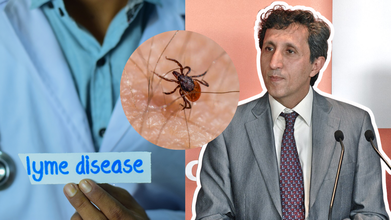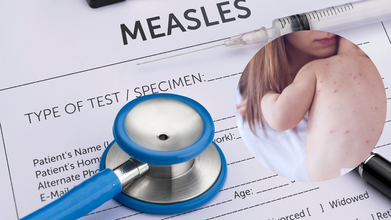- Health Conditions A-Z
- Health & Wellness
- Nutrition
- Fitness
- Health News
- Ayurveda
- Videos
- Medicine A-Z
- Parenting
- Web Stories
Can You Reverse Aging? Man Claims Bryan Johnson’s Blueprint Made Him 10 Years Younger, With Some Downsides

What if you could reverse the clock on aging—naturally? What would it be like to feel ten years younger, full of limitless energy, better health, and peak biomarkers. Too good to be true, you say? Well, one guy says he's done exactly that.
Max G, co-founder of health firm Join Zero, has been on Bryan Johnson's Blueprint, a draconian longevity protocol that aims to reverse biological aging. After two years of devotion, he claims to be 18 again biologically—10 years younger than his age! But is this groundbreaking anti-aging regimen really effective? And how much does it cost to stick to it? Let's take a closer look at his experience and get to the bottom of Johnson's ambitious Blueprint.
Max G posted on X (formerly Twitter) his experience with Blueprint. He stated in a post that prior to embracing Johnson's methods, he had perpetual fatigue, poor nutritional intake, and an irregular sleep pattern. But through perseverance with the program, his life was changed, and now he is ten years younger biologically. His biomarkers of cholesterol, blood sugar, and inflammation are all at optimal levels.
Looking back at his experience, Max G penned, "Almost 2 years on @bryan_johnson's Blueprint: in 2023: always tired, carb-loading, night owl habits. In 2024: turned things around, focused on health & longevity. 2025: 10 YEARS YOUNGER biologically (18 vs 28) with 90% of all biomarkers in optimal ranges."
How Does the Anti- Ageing Blueprint Really Work?
Blueprint is a carefully designed longevity regimen authored by Johnson himself. It is based on scientific studies and utilizes evidence-based methods to maximize multiple dimensions of health. As stated on the official Blueprint website, the program is centered on a few important pillars:
Diet: A precisely measured diet of nutrients aimed at feeding the body and slowing down ageing.
Exercise: A disciplined regimen of exercise geared towards keeping cardiovascular and muscular function in perfect shape.
Sleep Optimisation: Prioritizing rest and recovery to promote cognitive function and cellular repair.
Skincare and Supplements: An integrated regimen to facilitate skin health and overall longevity.
Johnson, who is self-styled as "the most measured person in history," regularly experiments and optimizes the program from real-time biological information. The process includes testing the biological age of more than 70 organs and modifying the routine accordingly.
Challenges of Following Blueprint
Although the results are impressive, Max G also pointed out the difficulties of sticking to such a rigid regimen. One of the main disadvantages, he said, was the effect on his social flexibility. Late-night meals and spontaneous excursions became challenging because of the strict regimen of Blueprint. Moreover, monitoring and sticking to the routine required a lot of effort and discipline.
But to balance this, Max G stuck to the 80/20 rule, which means he followed the protocol 80% of the time and had some room for flexibility in the other 20%. He recognized that his dedication varied with work requirements but insisted on consistency to reap long-term gains.
Aside from the physical changes, Max G divulged his largest takeaways from undergoing Blueprint. He underscored the necessity of focusing on three building blocks of health prior to considering other interventions:
Nutrition – Having a clean, nutrient-rich diet is the cornerstone of longevity and health.
Sleep – Maximizing rest and recovery supports cellular regeneration and brain function.
Exercise – Engaging in regular exercise is integral to maintaining a young body and mind.
In addition, he stressed the importance of monitoring improvement by saying, "You can only improve what you measure." He also urged people to establish a support network, as being in contact with similar individuals can enhance accountability and motivation.
Does the Blueprint Really Work?
Blueprint promises to enhance mood, cardiac health, vitality, concentration, and muscularity. Although anecdotal evidence such as Max G's case is compelling, the wider scientific establishment is yet to study the long-term implications of such an drastic regimen. Despite this, however, Johnson's biomarkers were said to be among the very best in the world, supporting the hypothesis that a protocol-driven longevity program could produce remarkable improvements.
The idea of reversing biological age is a developing science, and Blueprint is one of the most ambitious efforts to advance the limits of human longevitiy. Not everyone will be interested in adopting that kind of drastic lifestyle, but Max G's success indicates that even partial compliance with the principles of Blueprint can have quantifiable benefits for health.
As longevity research continues to move forward, methodologies such as Blueprint will become ever more sophisticated and available to the masses. As skeptics hold that extreme programs will not prove feasible for large numbers of people, pioneers like Bryan Johnson and Max G are a preview into what might become possible with targeted health monitoring and disciplined lifestyle adaptations.
For those interested in reversing aging, Blueprint offers an organized system. Yet, they advise that every individual will react differently and longevity depends on lasting persistence over instantaneous cures.
Max G’s experience with Blueprint serves as an intriguing case study in the field of longevity. His decade-long reversal in biological age underscores the power of disciplined lifestyle changes in reshaping health outcomes. While Blueprint remains an intense and highly structured regimen, its core principles—nutrition, sleep, and exercise—offer valuable insights for anyone looking to enhance their well-being.
As more people start experimenting with the methods of biohacking, the discourse related to turning around biological age has been continually on the move. Whether or not Blueprint is it, its presence in the longevous cause is indisputable.
Dr. Amir Khadir Pleads Guilty Over Controversial Treatments for a Nonexistent Form of Lyme Disease

Credits: Canva and Wikimedia Commons
Dr Amir Khadir, microbiologist and infectious disease specialist at Pierre-Le Gardeur Hospital in Terrebonne, Quebec, Canada pleaded guilty to 12 offences over his controversial treatment of Lyme disease. He had been treating patients with "chronic" Lyme disease since 2019 in his specialized clinic, affiliated to the hospital. However, science does not back that such a condition even exists, confirmed the disciplinary council of the Collège des médecins du Québec (CMQ).
In June 2020, he made a commitment to stop prescribing antibiotics beyond 28 days to treat people with Lyme disease, however, some patients have taken his medications for two years. His long-term antibiotic treatment lasted for more than four months up to two years in his patients.
Also Read: Is The White House Hiding Truth About President Donald Trump’s Health?
What Happened In The Past?
Dr Steven Lapointe, who is a CMQ trustee said that Dr Khadir "admitted four times rather than once that he had not respected his commitment. He spent much more time justifying himself than expressing regret, and even less remorse, for not having respected his commitment. [He made] his own law."
Dr Khadir justified his deed by saying that some of his desperate patients had recovered after prolonged course of antibiotics. He said that there were no complains from his patients about his approach. No complications were reported either.
Dr Khadir had earlier made the government aware of the need to undertake a research and was hoping to seek funding for the same. Le Journal de Montreal reports that he was not to offer antibiotic treatment for Lyme disease for more than 28 days, except as part of a hospital research project. However, as Montreal City News reports, that though he received the approval of the medical and political communities, the fundings had not come, as Quebec allocated the funds for a group of clinics specializing in long COVID and infectious diseases. Thus, he continued to offer antibiotic treatment beyond 28 days outside of a research setting.
"I regret not having done things in the right order. It was a lamentable error of judgment," he said.
Also Read: As U.S. Measles Cases Surge, Could The Country Lose Its Elimination Status?
What Is The Right Way To Treat Lyme Disease?
As per the Centers for Disease Control and Prevention (CDC), most cases of Lyme diseases are treated within 10 to 14 days of antibiotics.
Mayo Clinic notes that the standard treatment for Lyme disease is an antibiotic taken as a pill that lasts 10 to 14 days.
Cleveland Clinic also notes that while antibiotics are the primary treatment for Lyme disease, including doxycycline, amoxicillin, or cefuroxime axetil. The time taken to recover could be around 10 days.
Johns Hopkins Medicine notes that treatment could last up to 21 days.
What Is Lyme Disease?
It is a bacterial infection spread by infected ticks. The initial symptoms can include a 'bull's eye' rash, fever, headache, and fatigue. If it is left untreated, the infection could spread and cause more serious problems affecting joints, heart, and even the nervous system. It is most effectively treated, as many have noted and has been mentioned above, with antibiotics, especially when caught early.
Measles Outbreak: Cases Surge In South Carolina; After US, Canada's Elimination Status Too Could Be Threatened

Credits: Canva
Measles Outbreak: Measles is back again in America, with the Upstate South Carolina being hit by the outbreak again, and grown by 2 more cases. This has raised the state total to 25.
Health officials have confirmed that both the new infections were linked to close contacts of known cases. Those two in contact were under quarantine at home following exposures at two schools that had a high percentage of unvaccinated students. Of the state's 25 cases, 22 have occurred as part of the Upstate outbreak.
New York’s Rockland County has confirmed its second measles case in three months. The county, which saw a major measles outbreak in 2018–19 and has a sizable unvaccinated population, is once again on alert. Health officials said the new case is unrelated to the one reported in August, with the patient developing a rash soon after returning from an overseas trip last week.
Canada's Elimination Status Could Be Threatened By Measles Cases
October 28 marked one year of continuous measles transmission in Canada. This is a cycle of virus activity that is now threatening the country's elimination status.
As of now, the country has had more than 5,100 cases. This has been noted since the fall of 2024. This is more than double the number recorded in the past 25 years combined, which is why it is a cause of concern.
Canada had eliminated measles in past. In 1998, the disease was eliminated, however, with the new situation, the status of the country now seems to be in jeopardy. This is also because the elimination status requires an absence of the local virus transmission for at least 12 months.
According to CNN, the Pan American Health Organization (PAHO) is set to review and assess the measles elimination status of several North American countries during its annual meeting next month. In Canada, nearly 90% of the measles cases reported over the past year have occurred among unvaccinated individuals. Moreover, all but 157 of these cases have been linked to the ongoing outbreak that began in Ontario in October 2024.
In Israel too, as confirmed by The Jerusalem Post, eight child has died due to measles outbreak in the nation. The recent death is of a child, who was just 2-year-old. In Israel, all deaths in this outbreak have been noted in unvaccinated children under age 3 years.
Could US Too Lose Its Eliminated Status?
Measles has held “eliminated” status in the United States since 2000, a designation that means there had been no year-long, uncontrolled spread of the virus within the country for decades. But that milestone is now in jeopardy.
The infection is spreading again, and the Centers for Disease Control and Prevention (CDC) has reported 1,596 confirmed cases this year, the highest annual total in over thirty years. The actual number could be higher, says Dr. Paul Offit, director of the Vaccine Education Center at the Children’s Hospital of Philadelphia.
Why Are Cases Increasing In The US?
In Mohave County, Arizona, vaccination coverage among kindergartners dropped from 91% in 2019–20 to 78% in 2024–25, with a similar decline noted in southwest Utah.
Public health experts stress that at least 95% vaccination coverage is necessary to prevent the virus from spreading. Both Utah and Arizona allow parents to exempt children from school vaccine mandates on personal or religious grounds, leaving pockets of unprotected populations. Vaccine hesitancy has deepened since the Covid-19 pandemic, fueled by political polarization and a decline in public trust toward health authorities. Notably, most of the affected towns voted heavily for Donald Trump in the 2024 election, underscoring how politics and misinformation continue to shape vaccination decisions.
New Mpox Strain Detected in California Sparks Health Alert

Credits: Canva
More than two years after the mpox outbreak in the United States was officially declared over, a fresh cluster of cases in California has caught the attention of infectious disease experts.
The previous U.S. outbreak, which spread primarily among men who have sex with men, was declared over in early 2023, though sporadic cases have continued to appear. Now, health officials are worried after identifying three unrelated mpox cases in California linked to a more infectious and potentially more severe strain of the virus known as clade I mpox.
What Is Mpox?
Mpox, previously called monkeypox, is a viral infection caused by the monkeypox virus, a member of the Orthopoxvirus genus. According to the World Health Organization, the virus is divided into two main groups—clade I (which includes Ia and Ib) and clade II (which includes IIa and IIb). The 2022–2023 global outbreak was linked to the clade IIb strain. The disease continues to pose a global health concern, with a sharp rise in cases reported in the Democratic Republic of the Congo and other regions due to clades Ia and Ib, and now in the United States.
How This Strain Differs From the 2022 Outbreak
The mpox variant responsible for the 2022 outbreak belonged to clade II, a strain with a relatively low fatality rate. During that outbreak, over 32,000 infections were reported nationwide, resulting in 58 confirmed deaths—a mortality rate of about 0.2 percent.
Clade I mpox, by comparison, has been found to cause more serious illness and spread more easily. Both strains exist in parts of Central Africa, but clade I has historically shown higher transmissibility and mortality than clade II.
California Cases Raise Alarm Over Possible Community Spread
All three of the California patients infected with the clade I strain required hospitalization. According to the California Department of Public Health (CDPH), the pattern of infection suggests that, much like the 2022 outbreak, transmission is again occurring primarily within networks of men who have sex with men.
Dr. Joseph Cherabie, assistant professor of infectious diseases at Washington University in St. Louis and a board member of the HIV Medicine Association, said it was “only a matter of time” before clade I reached the U.S.
While a previous California case of clade I mpox was linked to travel in Africa, these recent infections have no known travel connections, a detail that worries experts. “That makes us a little bit uncomfortable as epidemiologists and as public health folks,” Cherabie said, adding that it signals local transmission that health authorities may not yet be fully detecting.
Transmission and Concerns About Undetected Cases
Mpox spreads mainly through direct skin-to-skin contact with someone who is infected, often through the painful rashes characteristic of the disease. Since the source of infection for these cases remains unclear, Cherabie believes there are likely more undetected cases circulating in the community.
When mpox first appeared in nonendemic countries in 2022, health agencies faced the challenge of having no treatments or vaccines made specifically for it. However, existing smallpox treatments were found to be effective against mpox, given their viral similarities.
Treatment and Vaccine Options
The smallpox vaccine Jynneos and the antiviral drug tecovirimat (Tpoxx) continue to be the leading tools for protection and treatment. Experts expect them to work against both clade I and clade II mpox.Jynneos requires two doses for complete protection, while Tpoxx can be given either intravenously or orally, depending on the severity of symptoms.
© 2024 Bennett, Coleman & Company Limited

